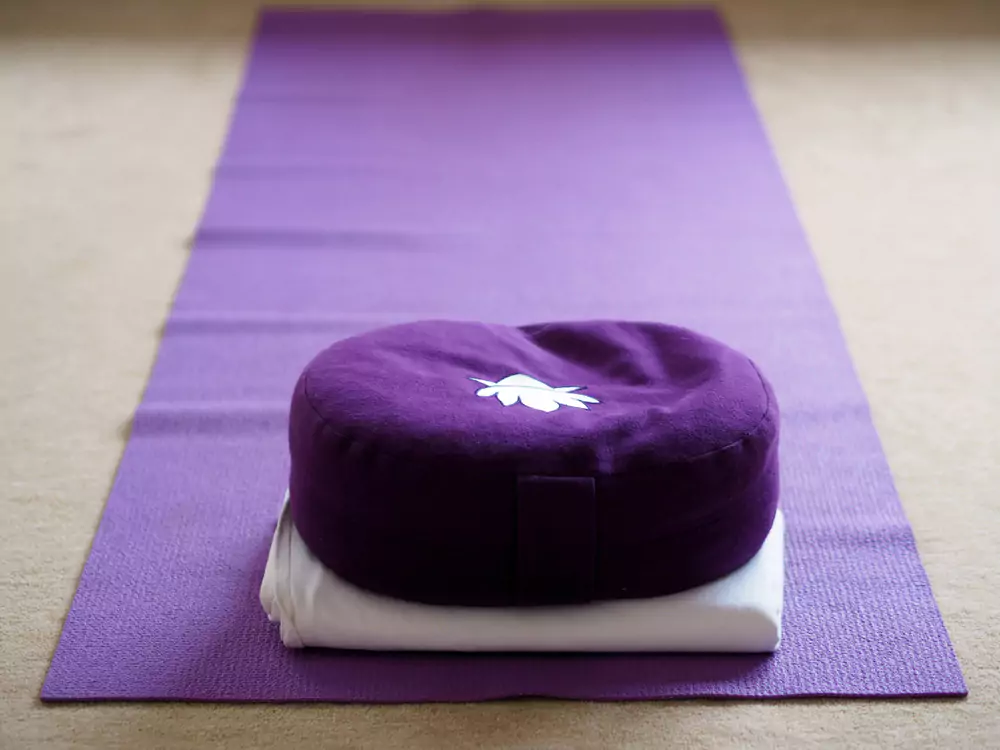
In today’s fast-paced world, finding moments of tranquility and inner peace has become necessary for many. Meditation offers an avenue to escape the chaos and reconnect with our inner selves. But how to sit on a meditation cushion?
One of the essential tools for a successful meditation practice is the meditation cushion, which enhances comfort and encourages proper posture for a deeper and more fulfilling experience. This article will delve into the art of sitting on a meditation cushion, exploring the proper techniques and benefits, and debunking common misconceptions.
The Magic of Meditation Cushions
Meditation cushions, also known as zafus or zabutons, have been used for centuries to aid practitioners in finding a stable and comfortable posture during meditation. They are typically filled with buckwheat hulls, kapok, or memory foam, offering varying levels of support. The shape and height of the cushion are designed to promote spinal alignment, preventing discomfort during extended meditation sessions.
Meditation is a powerful tool for reducing stress, improving focus, and cultivating a sense of inner calm. But for many people, finding a comfortable and sustainable position for meditation can be a challenge. Sitting on a meditation cushion can support proper posture and reduce discomfort during meditation.
The Benefits of Meditation Cushions
Meditation cushions, or zafus, come in various shapes and sizes. They are typically filled with buckwheat hulls or kapok fibers, which provide a firm but comfortable base for sitting. The primary benefit of using a meditation cushion is that it helps elevate the hips above the knees, reducing strain on the lower back and promoting proper spinal alignment. This can make it easier to maintain a comfortable and sustainable position for meditation.
By setting aside a special cushion for meditation, you create a physical reminder of your commitment to your practice. This can create a sense of sacred space and enhance your focus and concentration during meditation.
How to Sit on a Meditation Cushion

Choose a Comfortable Cushion
When choosing a meditation cushion, finding one that is comfortable and supportive for your body is important. There are a variety of shapes and sizes to choose from, including round cushions, crescent-shaped cushions, and square cushions. Try a few options to find one that feels comfortable for your body.
Find a Quiet Space
Choose a quiet and peaceful space for your meditation practice. It can be helpful to create a designated meditation space in your home, but if that’s not possible, find a quiet corner where you can sit without distractions.
Place the cushion on the floor
Position the meditation cushion on a clean and flat surface. If you’re using a zabuton, place it first, and then position the zafu on top. Ensure the cushion is centered and stable.
Sit cross-legged or in a kneeling position
- Cross-legged: Sit in the center of the cushion with your legs crossed, either in a full lotus (crossing your legs with each foot resting on the opposite thigh) or a half lotus (one foot on the opposite thigh, the other foot resting on the calf). If these positions are uncomfortable, you can also sit in a simple cross-legged position with both feet. Adjust your position so that your hips are elevated above your knees. This will help to maintain the natural curve of your spine and reduce strain on your lower back. You can add additional cushions or blankets under your hips to achieve the desired height if necessary.
- Kneeling: Kneel on the cushion with your knees wide apart and your shins and tops of your feet resting on the floor. You can use a meditation bench or additional cushions to support your buttocks and reduce strain on your knees.
Relax your shoulders and arms
Allow your shoulders to relax and gently roll them back and down. Rest your hands on your lap, with palms facing upward or downward, whichever feels more comfortable for you. You can also form a mudra (hand gesture) by touching your thumbs and index fingers together.
Keep Your Spine Straight
Keep your spine straight but relaxed. Allow your shoulders to relax downward and slightly back, lengthening the back of your neck. This will help to reduce tension in your shoulders and promote proper alignment in your neck and spine.
Adjust the cushion if needed
If you feel any discomfort or strain, adjust the cushion’s height or position. You can add or remove cushioning to find a comfortable height that supports your posture and allows your hips to relax.
Maintain a relaxed and alert posture
Find a balance between relaxation and alertness. Relax your body while keeping your mind attentive and focused.
Close Your Eyes or Gaze Downward
Once you’re comfortably seated, bring your attention to your breath and begin your meditation practice. Focus on your breath, a specific mantra, or any other meditation technique that you prefer. Close your eyes or gaze downward, and focus on your breath. Allow your thoughts to come and go without judgment. If you find your mind wandering, gently bring your attention back to your breath.

Troubleshooting Tips
If you experience discomfort or pain while sitting on a meditation cushion, try these tips:
- Experiment with different cushion heights or positions until you find what works best for your body.
- Use additional cushions or blankets to support your knees, ankles, or lower back.
- Try a different type of cushion, such as a meditation bench or chair.
- Consider incorporating a yoga or stretching practice to help improve your flexibility and reduce tension in your body.
Also read about: Do I Have Driving Anxiety? Quiz, Tips & Advice
FAQs
Conclusion
Sitting on a meditation cushion can support proper posture and reduce discomfort during meditation. Following these simple steps, you can create a comfortable and sustainable position for your meditation practice. Remember to be patient and kind to yourself as you explore different positions and cushions. With practice, you’ll find a position that works best for your body and enhances the benefits of your meditation practice.

